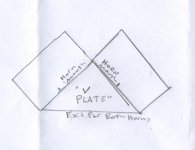I tried searching for info on real world results from V-Plating multiple Tapped horns, but didnt find much. I have seen and heard claims from FLH guys regarding increased spl by creating an effectively larger horn mouth by laying their enclosures on their side in a Vee arrangment with a cover. I know Art found increased performance from his Barn doors on his Keystone.
Has anyone tried this with their tapped horns, specifically wondering about a Tham, Keystone, or Danley style TH118. I wasn't sure how to model the increased volume in Horn resp or if setting the driver location farther back in the effective mouth of the horn was an issue. I know most TH's are a compromise on overall size and horn mouth area. Seems like V-Plating them would increase the horn mouth with minimal additional materials. Any downsides to this?
Thanks,
Has anyone tried this with their tapped horns, specifically wondering about a Tham, Keystone, or Danley style TH118. I wasn't sure how to model the increased volume in Horn resp or if setting the driver location farther back in the effective mouth of the horn was an issue. I know most TH's are a compromise on overall size and horn mouth area. Seems like V-Plating them would increase the horn mouth with minimal additional materials. Any downsides to this?
Thanks,
V-plating seems a bit of a fudge to me. The combined mouth size will be less than what could be achieved by simply stacking the horns side-by-side or one on top the other, so you're basically adding a "pinch" at the mouth, the amount of pinch being dependent on how deep the V is. Theoretically this will reduce the resonance frequency, and that may be desirable if the resonance frequency is too high to begin with, but SPL capability might be reduced as well (compared to simply stacking them).
You can simulate it in Hornresp.
Brian, it's not necessarily a "pinch", but it adds another section of controlled expansion.
Chris
Brian, it's not necessarily a "pinch", but it adds another section of controlled expansion.
Chris
You can simulate it in Hornresp.
Brian, it's not necessarily a "pinch", but it adds another section of controlled expansion.
Chris
The combined csa at the entrance to the V-plate section will be less than the csa at its exit.
Yep, I can see that now. Fair enough.
Bit more difficult to simulate in Hornresp without some fudging of that pinched bit.
Chris
Bit more difficult to simulate in Hornresp without some fudging of that pinched bit.
Chris
The picture below should give an idea of what is being discussed.Vplating?
A 90 degree angle is depicted, but any angle less than 180 and more than 0 would constitute a "V"
Depending on the ratio of horn "mouth" to frontal area, angle of the "V", and whether the entire front of each of the cabinets or just the smaller mouth exit CSA (Cross Sectional Area) is considered will result in different modeling results.
Art
Attachments
- Status
- Not open for further replies.
- Home
- Loudspeakers
- Subwoofers
- V-Plating Tapped Horns
